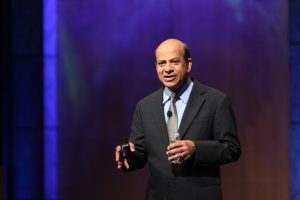
When companies launch innovation initiatives, they typically focus all of their time and energy on a feverish quest for the big breakthrough idea. But that initial spark of inspiration is merely a starting point. The real innovation challenge lies beyond the idea, in a long, complex journey from imagination to impact.
Vijay Govindarajan discussed the best practices for executing an innovation initiative to bridge the envision-to-execution gap at The Premier Business Leadership Series yesterday. Drawing on his extensive research and interviews with real companies, people and projects, Vijay translated his findings into understandable frameworks and practical advice for senior executives managing small-process and high-risk innovation initiatives.
Vijay is widely regarded as one of the world’s leading experts on strategy and innovation. He was the first Professor in Residence and Chief Innovation Consultant at General Electric, where he worked with the CEO, Jeff Immelt, to write "How GE Is Disrupting Itself," the Harvard Business Review article that pioneered the concept of reverse innovation – any innovation that is adopted first in the developing world.
Vijay opened his presentation by stating that “Strategy is about leadership and especially about leadership in the future.” Vijay asked the audience to think about how much of their times is spent in each of 3 boxes:
- Managing the present
- Selectively forgetting the past
- Creating the future
Time spent in box 1 is not about strategy; it’s important but it does not define the future. Radically different thinking processes are required between boxes one and boxes two and three. Box one is all about incremental improvements, whereas boxes two and three address non-linear challenges or opportunities. A non-linear strategy breaks the pattern of box 1 and seeks a radical solution, even to enduring challenges. Nonetheless, it is based on the world as it is, not as us box one thinkers would have it be - the ultimate pragmatism.
Asking, “Why do organisations struggle so much with boxes two and three?” Vijay said that it’s partly because we obsess about achieving incremental improvements in what we know and not looking often enough for a discontinuous change. This parallels Jim Collins’ finding that “Good is the enemy of great.” When you are good, you sometimes don’t feel the pressure to seek out an even better solution. “Good” in this context equates to the prevailing “dominant logic,” dogmatic adherence to a prior strategy that brooks no questioning and does not seek true innovation.
Future market leadership will not come from operational excellence (optimisation) alone, it will come from innovation and transformation. You need “breakthrough ideas” multiplied by “breakthrough execution.” (If you score zero in either, the end product is also zero. If one scores much lower than the other, focus there, says Vijay).
Vijay extolls creating a separate team for innovation. It needs different skills than an operational excellence team; both are needed and the relationship between them needs to be managed (breakthrough ideas x breakthrough execution). Finally, “amplify weak signals,” recommends Vijay. The future is full of unknowns, so proactively investigate any early indicators you can find by testing assumptions. Keep the cost of failure cheap; fail early, fail fast, fast cheap - so you can survive to try something else.
In conclusion, Vijay imparted this message, "The future is now." It’s time to make a start on your strategy.
